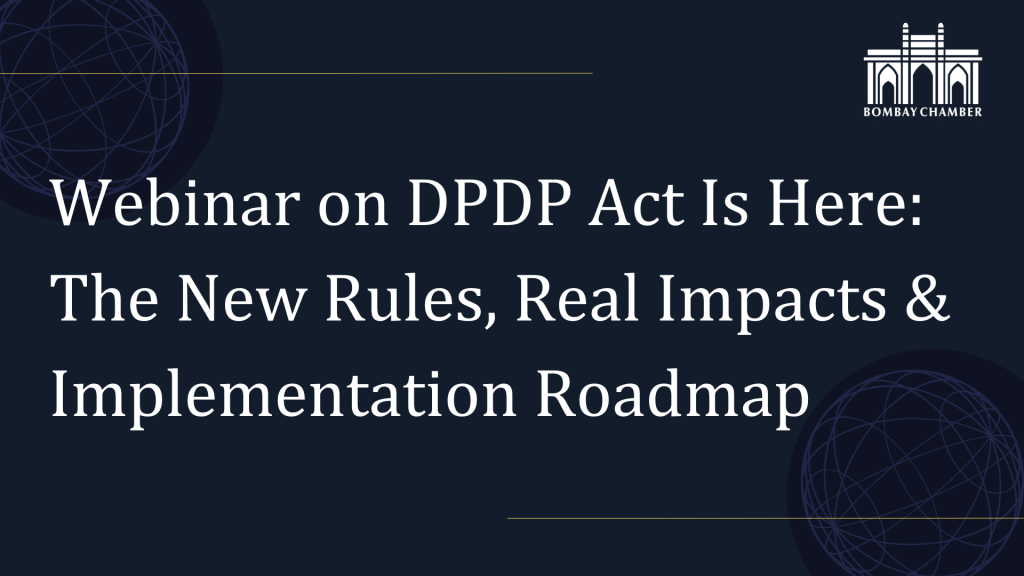Public Holidays in 2026 for Maharashtra under Negotiable Instruments Act
Notification attached
Top Stories
Public Holidays in 2026 for Maharashtra under Negotiable Instruments Act
Notification attached
Central Govt notifies Industrial Relations Code (Removal of Difficulties) Order, 2025 for continuation of Tribunals, Courts constituted under the Industrial Disputes Act 1947.
Copy of Notification attached

Mumbai: The Bombay Chamber of Commerce and Industry, through its Legal & IPR Committee, convened a high‑level webinar on the Digital Personal Data Protection (DPDP) Act and the newly notified rules. The programme brought together leading legal experts and industry representatives to explore the legislation’s wide‑ranging impact and to share practical insights on how businesses can adapt to an evolving regulatory environment.
Held on December 05, 2025, the session clarified the compliance requirements organisations must meet within the 18‑month transition period. Sandeep Khosla, Director General of the Bombay Chamber, delivered the welcome address and acknowledged the efforts of Attreyi Mukherjee, Co‑Chair of the Legal & IPR Committee and Vice‑President & Head of Legal, Mahindra & Mahindra (EV Business), for her role in actively shaping and planning the discussions.
Speakers Supratim Chakraborty, Partner at Khaitan & Co, and Sumantra Bose, Counsel at Khaitan & Co, outlined the scope of the Act and explained how it reshapes organisational accountability. They emphasised that the law introduces binding standards for consent, data minimisation, breach response, retention controls and governance. The discussion highlighted that these obligations are not routine adjustments but fundamental changes to how enterprises handle personal data.
Participants were reminded that the compliance window is short and that delaying action could expose organisations to operational disruption, legal consequences and reputational damage. The speakers examined practical steps for implementation, including revising contracts, updating internal processes and strengthening technical safeguards. They also addressed the role of consent managers, the handling of children’s data, and the responsibilities of significant data fiduciaries.
The session explored the challenges of breach reporting, particularly the requirement to notify multiple regulators and affected individuals. Attention was also given to data retention and deletion, with guidance on navigating the new framework. The speakers noted that organisations must prepare for audit‑ready governance and be able to demonstrate compliance at short notice.
Cross‑border data transfers were another area of focus, with discussion on how the rules alter existing practices and what safeguards are now expected. The webinar also touched on mergers and acquisitions, stressing that data protection considerations will become central to due diligence and transaction planning.
The panel discussion and Q&A session, moderated by Attreyi Mukherjee, Co‑Chair of the Legal & IPR Committee, Bombay Chamber and Vice‑President & Head of Legal, Mahindra & Mahindra (EV Business), highlighted the need for companies to treat compliance as an immediate priority, not something to be delayed. The speakers stressed that the Act requires organisations to act now, both to meet legal requirements and to maintain the trust of customers and stakeholders.
The webinar helped cut through the complexity of the legislation and gave attendees clear, practical insights. By explaining the law’s requirements and the risks of non‑compliance, it underscored the need for proactive preparation during the transition period.
(Write to us at editorial@bombaychamber.com)
Notification
Govt of NCT New Delhi publishes draft Rules under OSH Code 2020 for public comments.
Notification Link.
Notification
Govt of NCT Delhi publishes draft Rules under IR Code 2020 for public comments
Notification Link.
Due to non-availability of the Industrial Tribunals under the IR Code, pending cases under the Industrial Disputes Act, 1947 cannot be pursued any further – Delhi HC
Judgement attached
My No. MUM/TRD/TENDERS
Mr. Sandeep Khosla
Director General
Bombay Chamber of Commerce & Industry
Dear Mr. Sandeep Khosla,
Procurement Notice–State Pharmaceuticals Corporation of Sri Lanka
I wish to inform you that the Chairman, Departmental Procurement Committee of the State Pharmaceuticals Corporation of Sri Lanka has invited sealed bids for supply of following items to the Ministry of Health.
| Bid Number | Closing Date & Time | Item Description | Non – refundable Bid Fee (LKR) |
| DHS/L/WW/113/25 |
22.12.2025 at 09.00 a.m. |
Nutrient broth No 02, Mueller Hinton Broth and Gonococcal culture Agar Base | 3,000/- + tax |
Please find attached herewith a copy of the procurement notices of the above.
It would be appreciated, if you could kindly make necessary arrangements to disseminate the same among your membership.
With warm regards,
Shirani Ariyarathne
Consul
Consulate General of Sri Lanka
34, Homi Modi Street, Fort
Mumbai 400001
Tel: (+ 91 22 )22045861/22048303
Fax: (+ 91 22) 22876132
E -mail: slcg.mumbai@mfa.gov.lk
Public Holiday on 2.12.25 for elections for certain Local Government Bodies in Maharashtra
Public Holiday on 2.12.25 for elections for certain Local Government Bodies in Maharashtra
Notification attached
Voluntary retirement is deemed automatically accepted if not expressly rejected within the stipulated period – Delhi HC
Judgement attached.


It is a long established fact that a reader will be distracted by the readable content of a page when lookin


